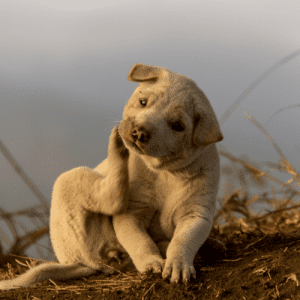
What Is The History Of The Kintamani Dog Breed?
The Kintamani, a breed steeped in Indonesian culture, originates from the Kintamani region of Bali, Indonesia. Revered as a cultural and spiritual symbol, these dogs have a history intertwined with local folklore and beliefs. They were traditionally used as companions to royal families and were highly regarded for their loyalty and regal presence. Kintamani dogs were often depicted in Balinese art and played a role in ceremonial rituals. Despite their historical significance, the breed faced challenges, including population declines. Efforts have been made to preserve and promote the Kintamani breed, recognizing its importance in Indonesia’s heritage.
What Does A Kintamani Dog Look Like?
The Kintamani is a medium-sized breed with a well-proportioned and elegant body. They have a short, dense coat that comes in a variety of colors, including white, cream, and black. Their eyes are dark and almond-shaped, reflecting their alert and intelligent nature. The ears are erect and pointed, contributing to their expressive and attentive appearance. The Kintamani’s tail is often carried high and may have a slight curve, adding to their graceful presence.
How Big Is An Adult Kintamani Dog?
Kintamani dogs are medium-sized with a balanced build. Males usually stand between 18 to 22 inches (46 to 56 cm) at the shoulder, while females range from 16 to 20 inches (41 to 51 cm). In terms of weight, adult Kintamani dogs generally weigh around 20 to 35 pounds (9 to 16 kg). Their size and proportions reflect their historical role as cherished companions to royal families.
Are There Other Dog Breeds Related To The Kintamani Dog?
- Australian Kelpie: Known for their herding abilities, Australian Kelpies and Kintamani dogs share a strong work ethic.
- Thai Ridgeback: Both breeds have distinct coat features and are known for their loyalty and independence.
- Phu Quoc Ridgeback: Hailing from Vietnam, these dogs share the ridgeback trait and adaptability.
- Formosan Mountain Dog: Native to Taiwan, these dogs share ruggedness and self-reliance with Kintamani dogs.
- Rajapalayam Dog: From India, Rajapalayam dogs exhibit loyalty and guarding instincts similar to Kintamani dogs.
- Carolina Dog: Similar to Kintamani dogs, Carolina dogs exhibit primitive traits and self-sufficiency.
- Indian Pariah Dog: Both breeds share a similar appearance and history of coexisting with human communities.
- Dingo: Native to Australia, Dingoes and Kintamani dogs share a certain ruggedness and adaptability.
These breeds, much like the Kintamani, embody unique traits and hold cultural significance within their respective regions.
What Is The Life Expectancy Of A Kintamani Dog?
Kintamani dogs typically have a lifespan of around 12 to 16 years when provided with proper care, nutrition, exercise, and regular veterinary check-ups. Their longevity reflects their generally robust health and well-being.
Can A Kintamani Dog Be Trained?
Yes, Kintamani dogs are intelligent and trainable, but their independent nature requires a patient and positive approach to training. Early socialization is essential to ensure they develop into well-mannered and well-adjusted companions. Positive reinforcement methods that incorporate rewards and encouragement work well with this breed. Their loyalty and willingness to please make them receptive to training that fosters a strong bond with their owners.
What Are Some Interesting Facts About A Kintamani Dog?
- Cultural Symbol: The Kintamani dog holds cultural significance in Balinese society, often associated with royalty, spirituality, and ceremonial rituals.
- Ancient Heritage: The breed’s history can be traced back for centuries, showcasing its enduring presence in Indonesian culture.
- Companion to Royalty: Kintamani dogs were historically valued as companions to royal families and were treated with great reverence.
- Artistic Depictions: The breed is often depicted in Balinese art, highlighting its importance and influence on local aesthetics.
- Color Variations: The Kintamani’s coat comes in a range of colors, adding to its individuality and diversity.
- Loyal and Devoted: Kintamani dogs are known for their loyalty to their families, often forming strong bonds with their owners.
- Independent Thinkers: Their intelligence and independent nature make them thoughtful and discerning companions.
- Playful Nature: Despite their regal appearance, Kintamani dogs have a playful side, enjoying interactive activities and games.
- Community Connection: The breed’s connection to Balinese culture and history underscores its role in the community’s identity.
- Preservation Efforts: Recognizing the breed’s significance, efforts have been made to safeguard and promote the Kintamani breed in Indonesia.
How Does A Kintamani Dog Interact With People?
Kintamani dogs are known for their loyalty and gentle nature, especially when it comes to their families. They form strong bonds with their owners and are attentive companions. While they can be reserved around strangers, their affectionate and playful side emerges when interacting with those they trust. Kintamani dogs are devoted companions, often displaying a sense of elegance and grace that echoes their historical significance. Their role as cultural symbols adds to their treasured status, making them valued and cherished members of Balinese households and communities.
